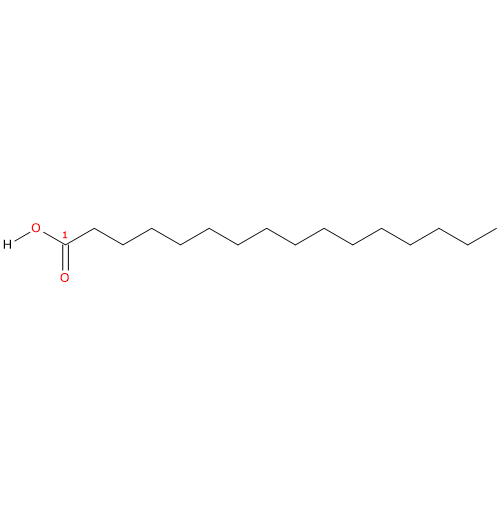Palmitic acid (16 carbon atoms), from the French word “palmitique”, was first purified by Chevreul M.E. in his research on butter and tallow (also known as beef fat) but surely characterized by Frémy E. in 1840 in saponified palm oil, from which its name.
It belongs to the group of saturated fatty acids, so it has no double bond and its shorthand notation is 16:0. It is also a member of the group called long chain fatty acids (LCFA), from 14 to 18 carbon atoms.
Palmitic acid is the first fatty acid produced during fatty acid synthesis in humans and the fatty acid from which longer fatty acids can be produced.
A curiosity: napalm was produced from derivatives of palmitic acid in combination with naphta. The name napalm derives from naphthenic and palmitic acids.
PROPERTIES
Molecular weight: 256.42408 g/mol
Molecular formula: C16H32O2
IUPAC name: hexadecanoic acid
CAS registry number: 57-10-3
PubChem: 985

In purified form it is a white crystalline scales insoluble in water, with melting point at 63-64 °C (145.4-147.2 °F; 336.15-337.15 K), and boiling point at 215 °C (419 °F; 488.15 K) at 10 mmHg.
OTHER NAMES
hexadecylic acid
cetylic acid
16:0
Food sources of palmitic acid
Palmitic acid is the commonest saturated fatty acid in plant and animal lipids, where it occurs as glycerol ester.
In fresh red and white meat, it is present in small quantities, with the highest values in the lamb, rabbit thigh, pork loin, and whole chicken with skin, all close to 2 g/100 g of edible portion. Goose is the exception, with a content of about 7.4 g/100 g of edible portion.
In processed and preserved meats, the content is far higher than fresh meat, and, except cured raw beef (Bresaola) and canned meat in jelly, it is higher than 2.4 g/100 g of edible portion, with values up to 7.6 g/100 g of edible portion in a type of salami (however, all the salami and lean pig’s trotter and stuffed pig’s trotter, dishes of Emilia-Romagna (ITA), are particularly rich). But, like for stearic acid, the highest values are observed in lard and suet, 21 and 24 g/100 g of edible portion, respectively.
Chicken, duck, goose and turkey eggs are a rich source. The highest content is found in the yolk (e.g. in chicken egg yolk, about 6 g/100 g of edible portion), and in whole egg powder (for chicken egg, about 10 g/100 g of edible portion).
In dairy products, it is present in:
- small amount in milk and yogurt (the highest value in sheep’s milk, 1.58 mg/100 g of edible portion);
- good amount in ricotta cheese (sheep’s milk), 2.85 g/100 g edible portion;
- high amount in cheeses, up to more than 8.4 g/100 g of edible portion in some seasoned ones, and butter, about 20.9 g/100 g of edible portion.
In fishery products, it is present in small quantities in some oily and semi-oily fish, with the highest values in fresh and smoked eel (4.5 and 4.8 g / 100 g edible portion, respectively) and tuna in oil (3.57 g/100 g of edible portion). A fair amount is also found fresh sardines and sardines in oil, fresh tuna, herring, fresh salmon, mackerel, sturgeon, and farmed gilthead bream. In the other fishes, mollusks and crustaceans, amounts are well below 1 g/100 g of edible portion.
Vegetable fats and oils, on the other hand, contain it in high amounts. Here are some examples:
- peanut butter and margarine, about 5.8 and 19.3 g/100 g of edible portion, respectively;
- palm oil, more than 41 g/100 g of edible portion, the highest value in absolute terms; high quantities are also found in wheat germ oil, corn oil, and olive oil, ever higher than 14 g/100 g of edible portion.
In oily fruits, it is present in high quantities, with the highest values in peanuts and dried coconut, 5 and 5.4 g/100 g of edible portion, respectively.
Quantities in cereals and cereal products are modest, rarely exceeding 1.2 g per 100 g of edible portion The highest quantity is found in oat, 1.11 g/100 g of edible portion.
In legumes, amounts do not exceed 1.6 g/100 g of edible portion (chickpeas, 0.64 g).
Note: milk and dark chocolate are an excellent source, with values of 8 to 9 g/100 g of edible portion.
Palmitic acid, with oleic acid and linoleic acid, is one of the three most abundant fatty acids in triacylglycerols of fat tissue and plasma lipoproteins.
References
- Akoh C.C. and Min D.B. “Food lipids: chemistry, nutrition, and biotechnology” 3th ed. 2008
- Chow Ching K. “Fatty acids in foods and their health implication” 3th ed. 2008